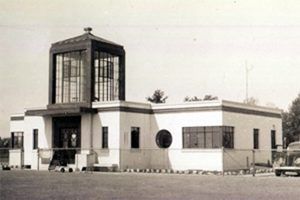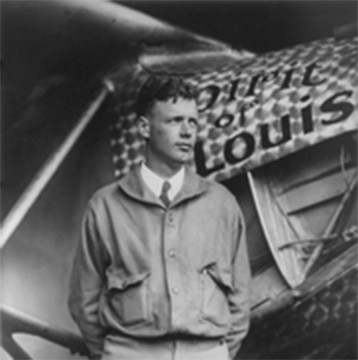 Aviation Museum of New Hampshire
Aviation Museum of New Hampshire
This classic, art-deco 1937 terminal served as Manchester’s aviation “front door” until replaced by the Ammon Terminal in 1961.
Relocated and restored in 2004 on the east side of the airport with funds from current airport management, the building now serves as the Aviation Museum of New Hampshire run by the New Hampshire Aviation Historical Society. Please visit www.nhahs.org for more information about the museum and hours of operation.
Airport Milestones
7 June, 1927
The Board of Mayor and Aldermen approve spending $15,000 to begin development of a Manchester airport. The Board is no doubt influenced by the words of renowned airfield construction expert Karl Kenniston, who had told them: “You have the best natural site for an airport of any municipality in New England -- bar none.”
25 June, 1927
Charles A. Lindbergh flies over Manchester in his Spirit of St. Louis, just two months after his historic solo flight across the Atlantic. Thousands gather to witness the event, but the best view belongs to those in downtown offices as Lindbergh cruises down Elm Street at roof-top level.
21 October, 1927
The newly formed Manchester Board of Aviation and Recreation approves construction of an airport on an 84-acre tract of land near Pine Island Pond. Ground is broken four days later and within a month two 1,800-foot runways are cleared.
November 1927
Robert S. Fogg is the first pilot to take off from the new Manchester Airport.
28 March, 1928
A two-seat Kreisner-Reidner Challenger becomes the first aircraft to designate Manchester its “home port.” It transports 212 passengers during its first month of service.
July 1928
Wartime flier W. Russell Hilliard forms Northeast Airways in Manchester.
January 1933
First passenger terminal opens. Manchester Airport plays host to another famous aviator when Amelia Earhart touches down in the Queen City during a Boston to Montreal flight.
January 1934
Scheduled airline service and airmail debut in Manchester when Boston, Maine and Vermont Airways adds the Queen City to its Boston to Montreal route.
January 1938
As air transportation flourishes, the parents of a Derry teenager treat him to his first plane ride, a flight from Manchester to Boston. The boy is hooked instantly. Later, the youth gets a job sweeping out hangars in exchange for flying lessons. His name is Alan B. Shepard, Jr.
January 1939
Carl Park and Arnold Butler launch Granite State Airways out of Manchester, offering flying lessons and other aviation services.
1 October, 1940
The Roosevelt Administration approves a $286,000 airport expansion project.
3 October, 1940
U.S. War Department announces Manchester has been selected as an Army Air Corps Base. Temporary military housing will cost $1.5 million.
20 May, 1941
First troops arrive, including 107 enlisted men and five officers. Area newspaper ads bid troops welcome.
6 December, 1941
First squadron of A-20 attack aircraft arrives at Manchester, 24 hours before Japanese attack Pearl Harbor. At its peak, some 6,000 troops were stationed in Manchester, including the 45th Bombardment Group and an anti-submarine squadron that destroyed at least two Nazi subs off the U.S. Atlantic coast.
February 1942
Manchester Air Base is renamed Grenier Field by War Department, in honor of Manchester native and West High School graduate Lt. Jean B. Grenier, who died in a training mission in 1934.
January 1951
U.S. Air Force grants special permission to Northeast Airways to resume operations out of Manchester and offer three daily flights to New York.
January 1955
Air Force responds to civic leaders and approves joint military-civilian use of Grenier Field.
26 January, 1959
Manchester Airport Authority (MAA) is formed. MAA is a City commission established by City Charter.
December 1961
New $850,000 passenger terminal opens at Manchester Airport. Terminal named after Roscoe A. Ammon, a successful businessman and airport booster who provided the City of Manchester with $500,000 in “seed money” to begin construction of modern terminal. Ammon died of cancer less than two weeks before the new terminal is opened.
January 1966
Air Force relocates all remaining flying units to other air bases and transfers control of Grenier Field to the municipalities of Manchester and Londonderry.
January 1978
Grenier Field/Manchester Municipal Airport officially renamed Manchester Airport.
January 1984
United Airlines begins jet service. First Ammon terminal addition is completed. Airport constructs additional ticket counters and administrative offices.
January 1986
USAir begins jet service.
January 1991
Second Ammon terminal addition completed. Airport adds four baggage slide doors and relocates car rental companies. The City of Manchester continues to plan for a new passenger terminal and major infrastructure improvements.
March 1992
“Phase I” of the redevelopment of Manchester Airport begins. Program includes new passenger terminal, taxiways, roadways and parking.
1 January, 1994
New 158,000 square foot passenger terminal opens at Manchester Airport. Modern facility offers many airport amenities, including: seven jet gates and five regional gates; three baggage carrousels; a choice of restaurants; an international newsstand; and ample, inexpensive short and long-term parking near the terminal.
January 1995
COMAIR Delta Connection begins jet service.
December 1997
“Phase II” of the redevelopment of Manchester Airport begins. Program includes runway and taxiway improvements, passenger terminal addition, parking garage and new airport entrance road. Runway improvement project gets underway.
December 1997
Manchester Airport surpasses one million passengers for the first time.
April 1998
Continental Airlines begins jet service to Newark-New York.
June 1998
Southwest Airlines, Northwest Airlines and MetroJet begin service. Manchester Airport enters a new era in air travel.
April 1999
Airport opens 75,000 square foot terminal addition, including three new jet gates, five regional gates and ninety feet of ticket counter space.
December 1999
Manchester Airport opens new, six-level, 4,800 space parking garage.
December 1999
Manchester Airport surpasses two million passengers for the first time.
January 2000
Delta Connection-ASA, begins service at Manchester with two round-trip jets each day to Atlanta.
August 2000
Air Canada begins first-ever regularly scheduled service at Manchester with three daily flights to Toronto, Ont.
September 2000
Delta Air Lines replaces Delta Connection-ASA with two roundtrip flights each day to Atlanta, GA.
December 2000
Manchester Airport surpasses three million passengers for the first time.
January 2001
New, 520 foot elevated pedestrian walkway, complete with moving sidewalks, opens connecting the parking garage to the passenger terminal.
July 2003
Pan Am begins service at Manchester Airport.
August 2003
Main runway, Runway 17-35, reopens after being reconstructed and lengthened from 7,000 feet to 9,250 feet.
February 2004
Airport opens second 75,000 square foot passenger terminal addition.
April 2004
FAA breaks ground on new 165-foot air traffic control tower at Manchester Airport.
June 2004
Independence Air begins service at Manchester Airport.
December 2004
Manchester Airport surpasses four million passengers for the first time.
December 2005
Manchester Airport welcomes almost 4.4 million passengers and sets new annual passenger activity record
18 April, 2006
The airport is officially renamed Manchester-Boston Regional Airport to better reflect the important role it now plays in New England travel
 Aviation Museum of New Hampshire
Aviation Museum of New Hampshire